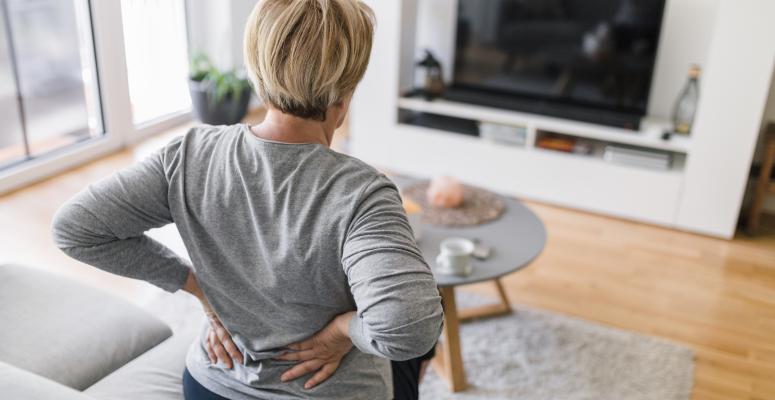
About 6% of U.S. adults are diagnosed with fibromyalgia, a chronic disorder characterized by widespread pain, tenderness, and stiffness in the muscles, tendons, and ligaments. It is often accompanied by fatigue, sleep disturbances, and cognitive difficulties such as difficulty concentrating and memory problems.
While symptoms of fibromyalgia can vary widely from person to person and can change over time, many people with fibromyalgia have difficulty performing daily activities, including work and household chores. Lower back pain is a common complaint among those with fibromyalgia.
Knowing how fibromyalgia and lower back pain are interconnected can help you pursue a treatment plan that is designed for your symptoms. Physical therapists can work with you during one-on-one sessions to address your back pain as well as your widespread fibromyalgia pain.
Why does fibromyalgia cause lower back pain?
The cause of fibromyalgia is not well understood, but it is thought to involve a combination of genetic, biochemical and environmental factors. It also has been linked to other conditions such as rheumatoid arthritis, lupus and chronic fatigue syndrome.
More research is needed on the link between fibromyalgia and lower back pain, but it is thought to involve changes in the way the central nervous system processes pain signals. You may also feel lower back pain because fibromyalgia can lead to full-body feelings of muscle weakness, which in turn can change a person’s posture and weight distribution over time. This can place more pressure on the lower back and cause inflammation and pain.
5 tips for managing fibromyalgia lower back pain
Fibromyalgia is a chronic condition, and there is presently no cure for it. Treatment typically involves a combination of medications, physical therapy, and lifestyle changes such as exercise and stress management. You can try the following noninvasive treatment options to manage your fibromyalgia-related lower back pain:
- Exercise regularly — Studies show that regular exercise can help reduce fibromyalgia symptoms, including lower back pain. Gentle exercises such as walking, swimming or yoga can be particularly beneficial for managing lower back pain related to fibromyalgia, as well as increasing strength, flexibility and endurance.
- Use heat and cold therapy — Applying heat or cold to your lower back can help to reduce pain and inflammation. A heating pad or hot water bottle can be used for heat therapy, while a cold pack or bag of frozen vegetables can be used for cold therapy.
- Practice good sleep hygiene — Getting enough quality sleep is essential for managing fibromyalgia pain. In fact, studies show that quality sleep is effective in reducing fibromyalgia pain. Creating a comfortable sleep environment and developing a regular sleep schedule can help to improve the quality of your sleep and reduce uncomfortable symptoms like lower back pain.
- Employ stress management techniques — Stress and anxiety can exacerbate fibromyalgia pain, so incorporating stress management techniques such as deep breathing, meditation, or yoga can help to reduce pain and improve overall well-being.
- Go to physical therapy — Physical therapy can help those with fibromyalgia-related back pain by addressing muscle weakness, improving flexibility and range of motion, and teaching exercises and techniques to manage pain. A physical therapist may also use modalities such as dry needling to stimulate and release tender points, increase blood circulation, and regulate pain signals. Additionally, a physical therapist can work with you to develop a comprehensive treatment plan that addresses your specific needs and goals.
It is important to consult with a health care professional if you suspect that your lower back pain is related to your fibromyalgia, as there are other conditions that can cause similar symptoms. Lower back pain can also be caused by conditions and injuries such as:
- Sciatica.
- Muscle strain.
- Tendinitis.
- Herniated disc.
- Stress.
If fibromyalgia is the source of your lower back pain, your doctor and physical therapist can work together to design a holistic and comprehensive treatment plan that takes your medical history, including fibromyalgia, into consideration.
Alliance PTP is ready to help you find top-notch PT for fibromyalgia-related back pain
Do you have fibromyalgia and experience a constant aching feeling in your lower back? Physical therapy can help you manage a range of fibromyalgia symptoms, including lower back pain. At Alliance Physical Therapy Partners, we’re proudly bringing together physical therapy practices across the country to help people get the high-quality PT they need.
Want to see a physical therapist in person? We can put you in touch with an Alliance PTP partner that’s close to you and that can help you address lower back pain linked to fibromyalgia.
Not keen on in-person PT sessions or not close to an Alliance PTP partner? No worries. We also offer effective and affordable virtual physical therapy through our Agile Virtual Physical Therapy platform.
Come find help for your fibromyalgia symptoms today!
Get Help at a Location Near You
